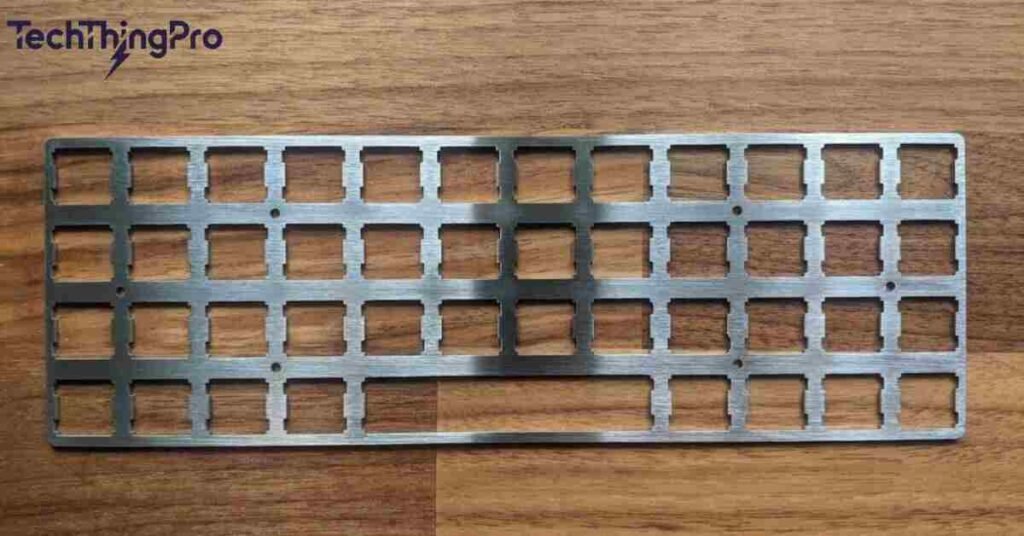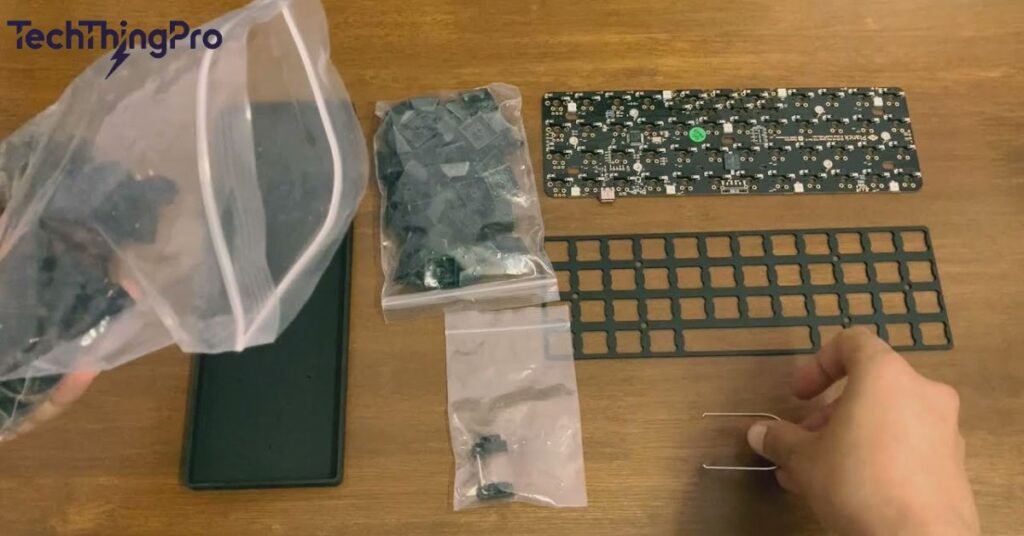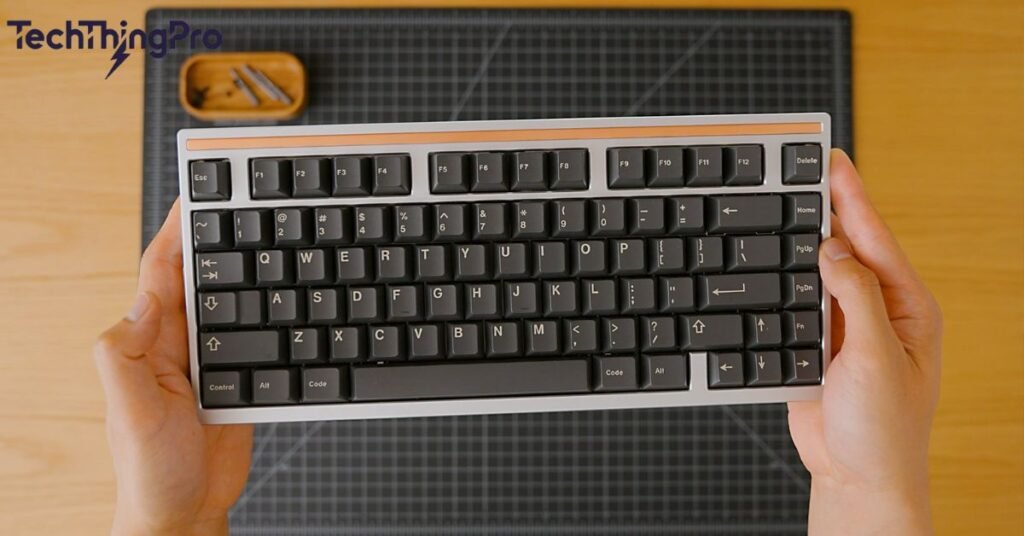Keyboard plates are essential parts of mechanical keyboards. They sit between the switches and the printed circuit board (PCB). These plates help support the switches, reduce wobble, and improve the overall typing experience.
In this guide, we will explore keyboard plates in detail. You’ll learn about different materials and their effects on typing feel. By the end, you’ll understand how to select the best keyboard plate for your needs.
What is a keyboard plate?

A keyboard plate is a critical part of most mechanical keyboards. It fits between the switches and the PCB, providing support and reducing switch wobble.
This simple yet essential part improves both the keyboard durability and the typing feel, especially when compared to a keyboard without a plate.
Not every keyboard has a plate. Some keyboards use plate-less designs, where the switches are mounted directly to the PCB.
While this gives a more direct typing experience, it can compromise the stability and durability of the keyboard.
A keyboard with a plate will feel more stable, making it a favorite choice for both casual typists and gamers.
Read 📖 More : 12 Simple Ways To Fix Your Fire TV Black Screen
Keyboard plate materials

There are various plate materials to choose from, and each one affects the typing feel and sound profile. These materials can range from metals like aluminum, copper, and steel, to more flexible options such as PC (Polycarbonate), POM (Polyoxymethylene), FR4, and carbon fiber.
Each material has different characteristics that make it suitable for specific needs and preferences. Some materials are stiffer, while others are more flexible.
Stiff plates like aluminum, steel, and copper create a more stable typing surface, while flexible plates like PC, FR4, POM, and carbon fiber give a softer feel. The choice of material also affects the keyboard sound feedback and overall keyboard aesthetics.
Copper plate
A copper plate offers a unique typing experience with a high-performance keyboard feel. It’s known for its plate stiffness and heavy sound profile, making each keystroke feel solid.
The typing sound is more pronounced and works well with tactile switches. Due to its durability, copper plates are often found in high-end keyboards and are perfect for those seeking a sturdy and responsive feel.
Steel plate
A steel plate is one of the most durable options for mechanical keyboards. It has a very stiff structure, which minimizes switch wobble. However, it can produce a slight metallic sound, often referred to as “ping.”
Despite this, its stiffness makes it an excellent choice for those seeking maximum keyboard stability and longevity. Steel plates are common in many custom and pre-built mechanical keyboards.
Aluminum plate
The aluminum plate is by far one of the most popular options in custom keyboard parts. It offers a balance between plate stiffness and plate flexibility, making it a middle-ground option.
An aluminum plate provides a smooth and solid typing feel, but without being as heavy as a steel or copper plate. Its moderate sound profile and lightweight nature make it a great choice for many users, especially for those looking for durability without the extra weight.
Read More : How To Reset Panasonic TV With & Without Remote?
PC plate
PC plates are known for their flexibility and soft typing experience. They offer a much quieter sound profile compared to stiffer plates like aluminum or steel.
The PC plate is also lighter and provides a cushioned feel with every keystroke. While it’s not as durable as metal options, it’s a favorite among those who prefer a quieter, softer keyboard feel.
POM plate
POM plates offer a unique thocky sound and are often used by gamers who enjoy a deeper sound when typing. This material is both soft and durable, making it perfect for those who prioritize a pleasant keyboard sound feedback. POM plates are more flexible compared to metal plates, offering a smooth typing experience while also being resistant to wear.
FR4 plate
An FR4 plate is made from the same material as most PCBs, offering a good balance between stiffness and flexibility. It provides a neutral typing feel that’s neither too soft nor too hard. FR4 plates are often favored by typists who want a plate with moderate plate stiffness and durability, offering a solid feel without being overly rigid.
Carbon fiber plate
Carbon fiber plates are both lightweight and stiff, making them a top choice for those seeking a unique look and a responsive typing feel.
The carbon fiber plate offers a crisp sound and is ideal for users who want a strong but lightweight keyboard.
While it’s not as widely used as aluminum or steel, it’s highly valued for its high-performance keyboard properties.
Summary
| Plate Material | Hardness | Sound Profile | Weight | Typing Feel |
| Aluminum | Moderate | Dull | Light | Balanced |
| Copper | High | Heavy | Heavy | Solid |
| Steel | High | Loud | Heavy | Rigid |
| PC | Low | Quiet | Light | Soft |
| POM | Low | Thocky | Light | Smooth |
| FR4 | Medium | Neutral | Medium | Neutral |
| Carbon Fiber | High | Crisp | Light | Crisp |
Do all keyboards have a plate?
All mechanical keyboards come with a plate. Some keyboards are designed without one, allowing the switches to be mounted directly onto the PCB. This design is preferred by some users because it provides a more direct typing experience and can offer a slightly softer feel.
Keyboards without plates may be less stable over time due to increased switch wobble. Most keyboards that do come with a plate benefit from enhanced keyboard durability and a more consistent typing feel.
Choosing a keyboard with or without a plate often depends on personal preference and the type of keyboard customization you’re interested in.
How do I choose the right plate for my keyboard?

When selecting the right keyboard plate, it’s important to consider your typing style and what you want from your Keyboard Plates. If you prefer a firm and solid typing feel, materials like aluminum, copper, or steel are ideal. For a softer, more cushioned typing experience, options like PC, POM, or FR4 may be more suitable.
Know Your Preference: Decide if you like a firm or soft typing feel. Firm plates like aluminum or steel are great for a solid touch, while soft plates like PC or POM are easier on the fingers.
Sound Level: Think about how loud you want your keyboard to be. Stiff plates (like copper and steel) create louder sounds, while soft plates (like PC and POM) are quieter.
Weight Consideration: Heavier plates (like steel) offer stability but may feel bulkier. Lighter plates (like aluminum or PC) are easier to handle.
Test Different Options: If you can, try out keyboards with various plates to find the one that feels right for you.
What are the different types of keyboard plates?
There are two main types of keyboard plates full plates and half plates. A full plate covers the entire key area, offering maximum keyboard stability and support. This is a great option for users who prioritize a solid and consistent typing experience across all keys.
A half plate, on the other hand, covers only part of the key area, allowing for more flexibility in typing feel. Half plates are often favored by those looking for a balance between stability and a softer typing experience.
What plate should I get for a gaming keyboard?
For a gaming keyboard, you’ll want a plate that balances durability, sound, and comfort. Many gamers prefer aluminum plates because they offer the right mix of plate stiffness and flexibility, ensuring a smooth but responsive typing experience. Carbon fiber plates are another popular option because of their lightweight nature and crisp typing feedback.
Aluminum Plate: Provides a good balance between stiffness and comfort. Ideal for quick responses.
Carbon Fiber Plate: Lightweight and delivers a crisp feel, great for fast-paced gaming.
Steel Plate: Very sturdy and stable, reduces switch wobble, making it perfect for competitive gaming.
PC Plate: Offers a softer touch and quieter sound, good for late-night gaming sessions without disturbing others.
Can I install my own keyboard plate?

Yes, installing a keyboard plate can be done with the right tools and a bit of patience. First, you’ll need to disassemble your keyboard, removing the switches and the PCB. Then, you can place the new plate between the switches and PCB, ensuring everything aligns correctly.
There are many online tutorials available to help guide you through the process, making it a manageable project even for beginners. Installing a keyboard plate not only allows for better keyboard customization, but it also gives you control over the feel and sound of your keyboard.
What advantages does a keyboard plate offer?
A keyboard plate offers several benefits that can significantly improve your typing experience. First, it adds rigidity and stability to the keyboard, minimizing switch wobble and creating a more consistent feel. This is especially important for fast typists or gamers who require precision in every keystroke.
Improved Stability: Plates keep switches in place, minimizing wobble and improving accuracy during typing and gaming.
Sound Control: The material of the plate affects how loud or soft your keyboard sounds, allowing you to customize your typing experience.
Increased Durability: Plates protect the PCB from damage, helping your keyboard last longer.
Enhanced Typing Feel: The type of plate impacts the overall typing experience. Stiffer plates provide a solid feel, while softer plates offer more cushioning.
Customization Options: You can change the plate to alter the look and sound of your keyboard, allowing for a more personalized setup.
Frequently Asked Questions
What is a keyboard plate?
A keyboard plate is a part of a mechanical keyboard that holds the switches in place. It sits between the switches and the PCB, providing stability and support.
How does the plate material affect typing?
The plate material influences the feel and sound of typing. Stiffer materials like steel create a solid feel, while softer ones like PC offer a cushioned experience.
Do all keyboards have plates?
All keyboards have plates. Some models, especially budget ones, might skip the plate for a more direct switch feel.
What is the best plate for gaming?
For gaming, aluminum and carbon fiber plates are popular choices. They offer a good balance of responsiveness and comfort for fast-paced play.
Can I change my keyboard plate?
You can change your keyboard plate if you have the right tools and knowledge. This customization allows you to improve your typing feel and sound.
Conclusion
Choosing the right keyboard plate can greatly enhance your typing experience. Whether you prefer a solid feel or a softer touch, there’s a plate material that fits your style. Understanding the differences between materials like aluminum, steel, and PC helps you make an informed decision.
With the right plate, your mechanical keyboard can be more enjoyable, stable, and durable. Dive into the world of keyboard plates and find the perfect fit for your needs. Happy typing!

Lily Watkins is an experienced tech writer specializing in the latest trends and innovations. She is passionate about making complex technology accessible and shares her insights on TechThingPro.com.

